Framing effects
- Camera obscura
- The Thames seen through an Arch of Westminster Bridge
- Westminster Bridge under Construction
- The picture within the picture
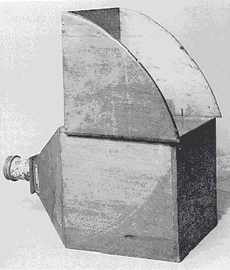
- Camera obscura
- Camera obscura inscribed “A. Canal”
Museo Correr, Venice
[click on the picture to enlarge it]
Paintings sometimes frame a fairly restricted field of vision, which may correspond to the angle covered by a camera obscura - an instrument used by the vedutisti, and probably Canaletto among them, to project through a lens an image of the landscape on to the paper where the outlines can then be drawn.
Painters frequently use the effect of a “frame within the frame”, showing a vista under the arch of a bridge, which provides a natural justification for the limited field of vision. This is the technique used by Canaletto in his painting The Thames seen through an Arch of Westminster Bridge ; Scott reworked the motif in a new way for his various versions of Westminster Bridge under Construction.
Camera obscura
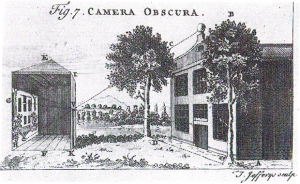
- Camera obscura
- [click on the picture to enlarge it]
The camera obscura was first used to emphasise the geometrical framing of buildings.

- Camera obscura
- (The Royal Collection © 2000 Her Majesty Queen Elizabeth II)
[click on the picture to enlarge it]
Then, as in Thomas Sandby’s view of Windsor Castle , several drawings made with the camera were placed side by side to offer wide angle views of buildings in their surroundings. Sandby, a topographer, made drawings of architectural settings and wide-angle views in London.
The Thames seen through an Arch of Westminster Bridge
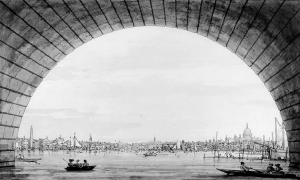
- Canaletto, The Thames seen through an Arch of Westminster Bridge
- (1746 drawing The Royal Collection © 2013 Her Majesty Queen Elizabeth II; Canaletto also made a painting of the same view, now in the collection of paintings at Alnwick Castle)
[click on the picture to enlarge it]
Canaletto gave several versions of this motif with its framing effect. In the painting the curve of the arch is varied by a hanging bucket which softens the strict symmetry, whereas in the drawing the counterbalancing effect is caused by the contrasting dark and light parts of the bridge. He also made views of the bridge seen from the river bank.
Westminster Bridge under Construction
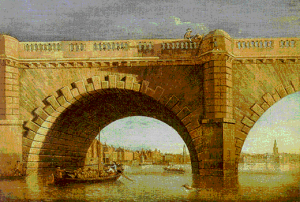
- Samuel Scott, Westminster Bridge under Construction
- (1750, c Tate, London, 2000)
[click on the picture to enlarge it]
Scott reworks the framing effect used by Canaletto in The Thames seen through an Arch of Westminster Bridge: the spectator being no longer supposed to be under the arch but in front of it, the foreground appears with the bricklayers perched on the parapet, which acts as surrogate observers offering a second imaginary viewpoint ; such a motif was becoming widespread, owing to the increased interest in the phenomenon of observers’ sympathetic identification with people in danger causing them to share their position imaginatively.
The bridges of London would lend themselves to such effects.
He had earlier used foreground motifs to increase the depth of field.
The effect here is based on a low-angle view which is adapted to the framing effect of the bridge, but he also used high-angle views, for instance in his painting of Covent Garden.
The picture within the picture
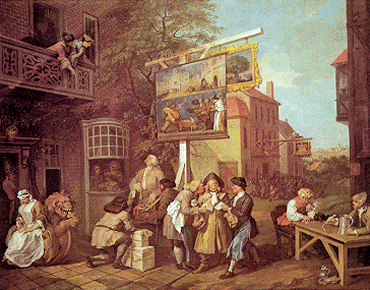
(1757, by Courtesy of the Trustees of Sir John Soane’s Museum, London)
- sign , )
A framing effect frequently used by Hogarth is that of “the picture within the picture” ; paintings hanging from the wall are usually moral comments on the scene. Views through the windows and shop-signs are also usually significant.
The sign of “Canvassing for Votes”, in the Election Series, above the elector approached by the agents of both candidates, represents Whitehall Palace. It is an ironical vignette of the work of Kent, the Palladian architect hated by Hogarth (the typical motif of the Venetian window is visible); below it, the vault is too low, causing the coach-driver to lose his wig.
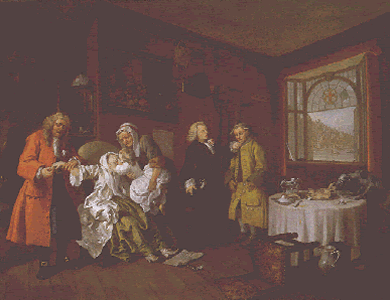
(1745, National Gallery, London)
- window , )
In the sixth and last scene of Marriage à la Mode a window opening on to London Bridge can be seen, which places the episode in the world of the City where the Countess has gone back to die at her father’s (the Alderman), after her husband’s death in a duel caused by his love affairs. This setting contrasts with the views of noblemen’s townhouses in the preceding episodes, which evoked the society into which she had married, in one of the usual alliances of City money with a coronet.

